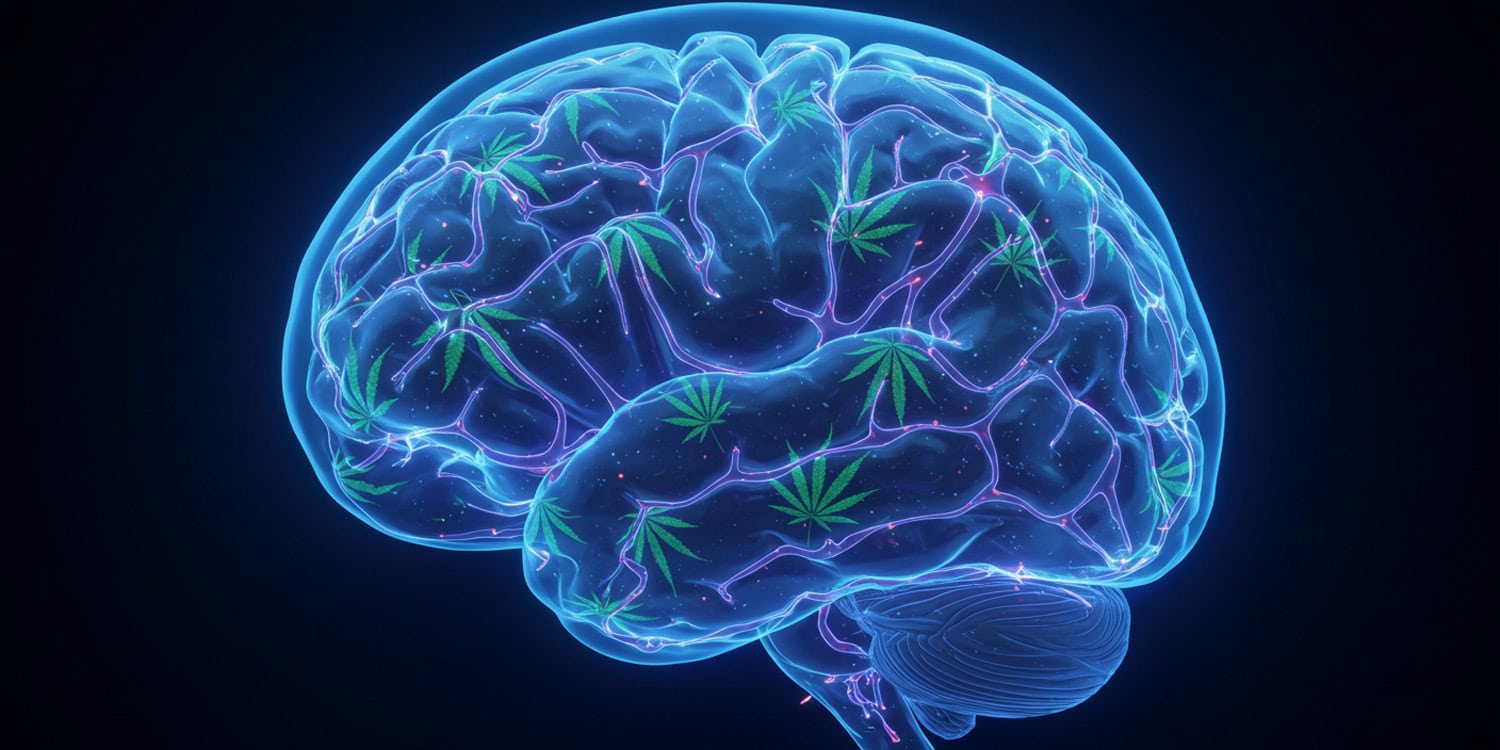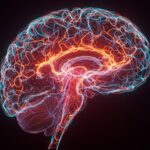A new study published in Psychopharmacology suggests that while teenage exposure to THC, the main psychoactive component of cannabis, may have limited long-term effects on certain thinking skills, it could make individuals more susceptible to the cognitive impacts of stimulants later in life. A team of scientists found that rats exposed to THC during adolescence showed a heightened response to amphetamine in a decision-making task as adults. This increased sensitivity to amphetamine did not appear to be linked to changes in typical dopamine pathways in the brain that are often associated with drug use.
Cannabis is a plant that contains a variety of chemical compounds. One of the most well-known and studied of these compounds is delta-9-tetrahydrocannabinol, or THC. THC is the primary psychoactive component of cannabis, meaning it is the substance that is mainly responsible for the “high” or altered mental state that people experience when they use cannabis. When someone consumes cannabis, THC enters the bloodstream and travels to the brain. In the brain, THC interacts with a system called the endocannabinoid system. This system plays a role in regulating various bodily functions, including mood, appetite, sleep, and even cognitive processes like learning and memory.
Cannabis is one of the most commonly used recreational drugs by adolescents, and in many parts of the world, it is becoming more readily available due to changing laws and social attitudes. While cannabis is often perceived as relatively harmless, there is accumulating evidence suggesting that early exposure to cannabis, and specifically THC, might have negative consequences for brain development and mental health. Human studies have shown correlations between adolescent cannabis use and later problems with thinking and memory, as well as an increased risk of developing serious mental illnesses like schizophrenia and addiction.
However, scientists face a significant challenge when trying to understand these links in humans. It’s difficult to definitively prove that cannabis use causes these later problems. For example, individuals who start using cannabis in their teens might also have other factors in their lives, such as genetic predispositions or challenging environments, that could contribute to both their drug use and any later cognitive or mental health issues. To overcome this hurdle and establish whether THC itself plays a direct role in these potential long-term effects, researchers often use animal models, like rats. Studying rats allows scientists to carefully control THC exposure and examine its impact on brain development and function in a way that is not possible in human studies.
Adolescence is a particularly sensitive time for brain development. During this period, the brain undergoes significant changes, especially in areas like the prefrontal cortex, which is responsible for complex cognitive functions like decision-making, planning, and impulse control. The prefrontal cortex and its connections that rely on dopamine, a neurotransmitter involved in reward, motivation, and cognition, continue to mature throughout adolescence. By using a rat model, the researchers aimed to investigate whether exposing adolescent brains to THC could specifically disrupt the development of dopamine-related cognitive functions controlled by the prefrontal cortex, and whether these disruptions would persist into adulthood.
“Cannabis is increasingly available to people of all ages, and some evidence from humans and animals suggest that when adolescents use this drug, it may have long-lasting effects on their brain by disrupting normal brain development that occurs in adolescence. If true, this would be of major public health concern, and I believe we need to know more about what cannabis, and the main psychoactive drug in it THC, does to brain development and risk for psychiatric disease,” said study author Stephen V. Mahler, a professor and director of the Irvine Center for Addiction Neuroscience at the University of California, Irvine.
The researchers used a group of Long Evans rats, a common type used in research. Some of these rats were given daily injections of THC throughout their adolescence (from 30 to 43 days after birth, roughly equivalent to human adolescence). Another group of rats received injections of a vehicle solution without THC, serving as a control group. After a period of over three weeks to ensure the THC was completely cleared from their systems, the rats were tested on a series of cognitive tasks in adulthood.
First, the rats were trained to associate pressing levers with receiving banana-flavored food pellets. This initial training ensured all rats understood the basic task of working for food rewards. Next, the rats were trained in a visual cue discrimination task. In this task, lights above the levers signaled which lever to press to get a food pellet. The researchers measured how quickly the rats learned this new rule, counting the number of trials and errors made before reaching a consistent level of correct responses.
Following the visual cue task, the rats were tested on a set-shifting task. This task assessed cognitive flexibility – the ability to switch between different rules. Initially, rats were trained to press a lever based on the visual cues, as in the previous task. Then, without warning, the rule changed. The visual cues became irrelevant, and the rats had to learn that now only pressing a specific lever (either the left or the right, regardless of the light) would result in a reward. The researchers again measured trials and errors to see how well the rats adapted to the new rule.
Finally, the rats participated in a probabilistic discounting task, which assesses decision-making under conditions of risk and reward. In this task, rats could choose between two levers. One lever always provided a small reward (one food pellet). The other lever offered a larger potential reward (four food pellets), but the chance of actually receiving the larger reward decreased throughout the testing session. In the beginning, the “risky” lever almost always delivered the four pellets. But as the session progressed, the probability of getting the large reward from the risky lever became lower and lower, sometimes delivering nothing. This task measures how rats weigh the certainty of a smaller reward against the possibility of a larger, but less probable, reward.
After the baseline cognitive testing, the rats were given amphetamine challenges. Amphetamine, a stimulant drug, is known to affect dopamine systems in the brain and can influence cognition and decision-making. The rats were given different doses of amphetamine, or a saline injection as a control, before performing the probabilistic discounting task again. This allowed the researchers to see how amphetamine affected decision-making in rats with and without a history of adolescent THC exposure.
In a separate set of experiments, the researchers used a more specialized technique called chemogenetics. In these experiments, rats were genetically modified to allow for the activation of specific dopamine neurons in the brain using a drug called clozapine-N-oxide (CNO). Some rats had these modifications targeted to dopamine neurons in the ventral tegmental area (VTA), a key brain region involved in reward and motivation. Others had modifications targeting dopamine neurons projecting from the VTA to the prefrontal cortex. These rats were also tested on the probabilistic discounting task after receiving CNO or a control injection, to see if directly stimulating these specific dopamine pathways would affect their decision-making.
The researchers found that adolescent THC exposure had some selective effects on cognition in adulthood. Interestingly, female rats that had received THC during adolescence actually learned the initial visual cue discrimination task faster than control females. However, adolescent THC exposure did not have a major impact on performance in the set-shifting task or on baseline decision-making in the probabilistic discounting task for either male or female rats.
The most striking finding emerged when the rats were given amphetamine. Rats with a history of adolescent THC exposure showed a greater increase in “risky” choices in the probabilistic discounting task after receiving amphetamine compared to control rats. This was particularly evident in female rats. In other words, amphetamine made the THC-exposed rats more likely to persistently choose the lever with the potentially large reward, even when that reward became increasingly unlikely. This suggests that adolescent THC exposure may heighten sensitivity to the cognitive effects of amphetamine in adulthood.
“Results show relatively minor changes in attention, cognition, and decision making in individuals that had been exposed to human-relevant levels of THC throughout early adolescence. However, we found that the cognitive effects of amphetamine, a drug that is both abused and prescribed for disorders like ADHD, were potentiated in adults with a history of THC use.”
When the researchers tried to mimic the effects of amphetamine by directly stimulating VTA dopamine neurons, or VTA dopamine projections to the prefrontal cortex, using chemogenetics, they did not observe the same potentiation of risky choice. Stimulating these dopamine pathways did not significantly alter decision-making in the probabilistic discounting task in control rats, and only had a minor and somewhat inconsistent effect in THC-exposed rats. This suggests that the heightened sensitivity to amphetamine seen in THC-exposed rats might not be due to changes in the activity of these specific dopamine pathways, but rather to other mechanisms influenced by amphetamine and adolescent THC exposure.
“We were surprised that adolescent THC changed how amphetamine altered decision making, but that these changes did not seem to result from alterations in major dopamine neuron populations or pathways, since amphetamine is usually thought of as a drug that strongly increases dopamine neurotransmission. This pattern of results could indicate that adolescent THC instead alters other cognition-related brain regions, or other neurotransmitter systems impacted by amphetamine such as norepinephrine or serotonin.”
Looking ahead, the researchers plan to continue their investigations to better understand how early exposure to a substance found in cannabis alters brain development and behavior. Future studies may explore different doses, methods of administration, and additional behavioral tasks to see how these variables affect the outcomes. The scientists are also interested in uncovering the exact brain mechanisms behind these changes, including whether other parts of the brain and other signaling systems contribute to the heightened sensitivity to stimulants. This line of research is important because it provides insight into how early drug exposure might increase the risk for mental health problems later in life.
“We are continuing to study the mechanisms by which adolescent THC exposure alters neurodevelopment, leading to long-lasting changes in the brain and behavior. This basic science, but translationally-oriented work is funded by an ongoing grant from the NIH. Such basic science research sets the stage for understanding how risky behaviors like youthful drug use can lead to psychiatric disorders like addiction and depression, and for developing altogether new clinical approaches for preventing and treating psychiatric disease.”
“This project took PhD student Maricela Martinez over 3 years to complete, and would not have happened without her hard work, troubleshooting, and persistence. We also thank our international collaborator Stan Floresco, who contributed invaluable input on the planning of the project, and interpretation of the data.”
The study, “Adolescent THC impacts on mPFC dopamine-mediated cognitive processes in male and female rats,” was authored by Maricela X. Martinez, Vanessa Alizo Vera, Christina M. Ruiz, Stan B. Floresco, and Stephen V. Mahler.




